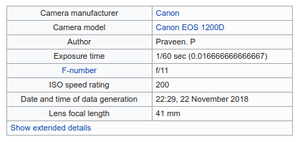 Exif of a file in Wikimedia Commons (compact form) | |
| Filename extension | |
|---|---|
| Developed by | JEIDA, now JEITA, CIPA |
| Initial release | 1995[3] |
| Latest release | |
| Extended from | TIFF, JPEG, WAV |
| Extended to | DCF |
Exchangeable image file format (officially Exif, according to JEIDA/JEITA/CIPA specifications)[5] is a standard that specifies formats for images, sound, and ancillary tags used by digital cameras (including smartphones), scanners and other systems handling image and sound files recorded by digital cameras. The specification uses the following existing encoding formats with the addition of specific metadata tags: JPEG lossy coding for compressed image files, TIFF Rev. 6.0 (RGB or YCbCr) for uncompressed image files, and RIFF WAV for audio files (linear PCM or ITU-T G.711 μ-law PCM for uncompressed audio data, and IMA-ADPCM for compressed audio data).[6] It does not support JPEG 2000 or GIF encoded images.
This standard consists of the Exif image file specification and the Exif audio file specification.
- ^ "Extensions to the PNG 1.2 Specification, Version 1.5.0". ftp-osl.osuosl.org. 2017-07-15. Retrieved 4 March 2021.
- ^ "The Metadata in WEBP (.webp) files". dev.exiv2.org. Retrieved 16 Feb 2022.
- ^ "Exif Exchangeable Image File Format, Version 2.2, Sustainability of Digital Formats: Planning for Library of Congress Collections". Library of Congress. 26 February 2014. Retrieved 2020-08-18.
- ^ a b Cite error: The named reference
exif30-iptcwas invoked but never defined (see the help page). - ^ "Exif2-1.PDF" (PDF). Archived from the original (PDF) on 2013-11-11.
- ^ "Standard of the Camera & Imaging Products Association, CIPA DC-008-Translation-2012, Exchangeable image file format for digital still cameras: Exif Version 2.3" (PDF). Retrieved 2014-04-08.